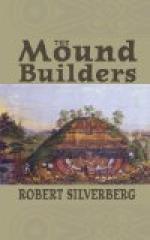But to come back to the mound, I now describe a sandstone disk, 1-1/2 inch in diameter and 3/4 inch thick, taken up from near the skeleton in the lower part of Grave Creek mound. According to Schoolcraft’s analysis, communicated to the American Ethnological Society, “Of the 22 alphabetic characters, 4 correspond with the ancient Greek, 4 with the Etruscan, 5 with the old Northern runes, 6 with the ancient Gaelic, 7 with the old Erse, 10 with the Phoenician, 14 with the old British,” and he also adds that equivalents may be found in the old Hebrew. It is, as some writers have described it, an exceedingly accommodating inscription. The following readings have been given:—
By M. Levy Bing: “What thou sayest, thou dost impose it, thou shinest in thy impetuous clan, and rapid chamois.” By M. Maurice Schwab (1857): “The chief of emigration who reached these places, has fixed these statutes forever.” By M. Oppert: “The grave of one who was assassinated here. May God, to revenge him, strike his murderer, cutting off the hand of his existence.” We can only say of these readings what a Hebrew Rabbi said to an indolent student, who in reading a verse in the Psalms in the original, gave the translation of the next verse, “Gentlemen, that is a very free translation.” Besides this, other readings have been given, all of which have the advantage that few can contradict them.
In the Scioto valley, where there are many very interesting remains of the Mound-builders, there are many burial mounds which have lately been opened. In many of these, the casts of unhewn logs are still visible, showing that the dead were placed in a rude vault, which was afterwards covered by soil. One skeleton was found to have round the neck several hundred beads, made mostly of marine shells, others made of the tusks of animals and a few laminae of mica. In the same mound from which this skeleton was taken, the vault gave strong evidence of its having been set on fire during the burial ceremony,—the large quantity of charcoal proving that it was suddenly quenched by the fresh soil heaped upon it.
If these Mound-builders were Sun-worshippers, as may safely be concluded from tablets and from rock markings, as well as from the fact of their sacred enclosures mostly looking towards the east, where the early rays would fall upon the altar, we may easily account for the fire having a share In the burial ceremony. Some have concluded that the blazing fire signified “life,” and that the sudden quenching signified “death.”




